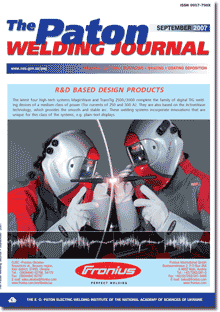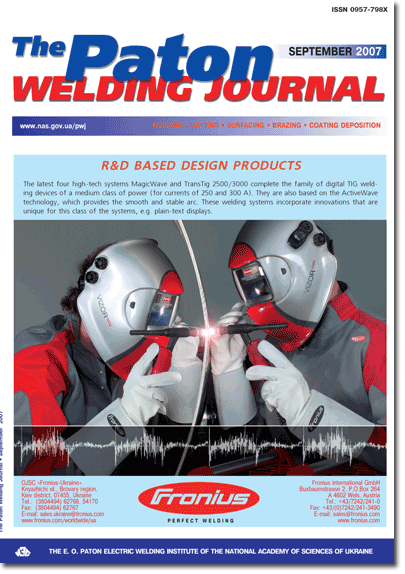

| SCIENTIFIC AND TECHNICAL | |
| Smiyan O.D., Kuchuk-Yatsenko S.I., Kharchenko G.K., Zyakhor I.V., Butkova E.I. and Nikolnikov A.V. Distribution of interstitial impurities within the joining zone in friction welding | 2 |
| Distribution of interstitial impurities (oxygen and hydrogen) in joints on steel 10G2FB produced by friction welding was studied using the local mass-spectral analysis procedure and equipment fitted with a laser probe. The nature of distribution of interstitial impurities in the joining zone produced by different friction welding methods (conventional and inertia) was experimentally determined. | |
| Kulik V.M., Vasiliev V.G., Grigorenko G.M., Savitsky M.M. and Doroshenko L.K. Phase and structural transformations in welding and arc treatment of 30KhGSA steel joints | 6 |
| Considered are structural changes in weld metal of 30KhGS type on high-strength steel joints occurring in welding and arc treatment. Under these conditions austenite transformation of hardened metal of the joint occurs at temperatures close to A1 and A3 of steel in as-delivered state. Subsequent cooling provides recovery of the hardening structure. Short-time heating in the intercritical temperature range causes formation of a substantial amount of temper ferrite and reduction of the amount of martensite formed during subsequent cooling at the expense of increase of the ferrite and bainite components. This leads to the highest decrease in hardness and increase in impact toughness of the metal. This improvement of properties and increase in crack resistance of the welded joints takes place after short-time heating to tempering temperatures. | |
| Labur T.M., Grinyuk A.A., Taranova T.G., Kostin V.A. and Poklyatsky A.G. Features of micromechanism of fracture in joints of aluminium-lithium alloys produced by plasma welding | 11 |
| Comparative analysis of fracture toughness of metal of welds in high-strength aluminium-lithium alloys 1420 and 1460 produced by plasma welding in the gravity position and with backing using serial welding wires SvAMg63 and Sv1201, has been carried out. Peculiarities of fracture micromechanism of welded joints in case of off-centre tension are determined on the basis of analysis of specimen fracture. | |
| Makhnenko O.V. and Muzhichenko A.F. Mathematical modelling of thermal straightening of cylindrical shells and shafts with distortions along their longitudinal axis | 17 |
| Numerical study of the deformed state of cylindrical shells in local heating was performed using thermoplastic analysis and finite element method. Calculation algorithms and procedure for determination of parameters of thermal straightening, based on the approximate method of shrinkage function, were developed. The procedure was used for thermal straightening of long cylindrical shells with general distortion deformations of their longitudinal axis caused by circumferential butt welds, as well as straightening of long auger shafts with longitudinal deflection deformations. | |
| Ignatenko A.V. Mathematical model of transportation of hydrogen by edge dislocation | 23 |
| Suggested is the model of transportation of hydrogen atoms by edge dislocation, based on the theory of diffusion. An equation of hydrogen diffusion in the field of a moving edge dislocation is proposed, which allows calculation of the amount of hydrogen transported by the dislocation depending upon the metal temperature, velocity of the edge dislocation, and concentration of free hydrogen. As shown by numerical calculations, transfer of hydrogen by the edge dislocation has maximum at a temperature close to the normal one. The results obtained are in good agreement with peculiarities of reversible hydrogen-induced brittleness. | |
| INDUSTRIAL | |
| Shlepakov V.N., Ignatyuk V.N., Kotelchuk A.S. and Gitin Yu.M. Mechanized repair welding of metallurgical complex units using flux-cored wire | 28 |
| Technological parameters and welding productivity in case of application of the wire of three types were determined on the basis of experimental investigations of the welding technique of typical joints of the metallurgical complex units using self-shielded flux-cored wire. Advisability of using the double-layer wire in welding of the metal of medium and high thickness in downhand and horizontal positions of the welds is shown. It is expedient to use tubular wire of small diameter in fulfillment of welds in vertical and overhead positions. Technology for welding of typical metal structures was developed. | |
| Yushchenko K.A., Chekotilo L.V., Nastenko G.F., Danilov Yu.B., Kachanov V.A., Kabashny A.I., Ivanuna S.N., Dorn V.R., Ilienko V.V., Ambrozyak N.V., Kisly B.P. and Khodan T.M. Extension of life of large-size concentrated sulphuric acid storage tanks | 34 |
| Possible causes of accelerated corrosion of elements of large-size concentrated sulphuric acid storage tanks with a capacity of up to 3000 m3, made from steel St3, are considered. Specifications and technology developed for repair of the tanks, allowing extension of their service life, are reviewed. | |
| Eryomin E.N. Modification of weld metal in electroslag welding of KhN77TYuR refractory alloy | 38 |
| For manufacturing of annular billets, used in the aviation engine building, it is proposed to use electroslag welding by a combined electrode with modification of the weld metal by disperse particles of titanium carbonitride. Results of the weld metal investigation in welding of the KhN77TYuR alloy are presented. Advantages of new welding technology are demonstrated. | |
| Poklyatsky A.G., Ishchenko A.Ya. and Yavorskaya M.R. Strength of joints on sheet aluminuim alloys produced by friction stir welding | 42 |
| The paper deals with the features of weld formation in fusion welding of aluminium alloys under the impact of high-temperature heating, and friction stir welding, ensuring weld formation due to plastic deformation of the metal in the welding zone. Technological sequence of friction stir welding process is given and the main principles of its implementation using the designed laboratory unit are described. Strength and ductility indices of welded joints on sheet (1.8Д2.4 mm) high-strength aluminium alloys produced by nonconsumable-electrode argon-arc and friction stir welding have been analyzed. | |
| Gavrish V.S., Rudenko P.M. and Podola N.V. System of automatic control and monitoring of resistance spot welding | 45 |
(You are viewing the simplified file contents)
The cost of subscription/purchase order journals or individual articles
| Journal/Currency | Annual Set | 1 issue printed |
1 issue |
one article |
| TPWJ/USD | 384 $ | 32 $ | 26 $ | 13 $ |
| TPWJ/EUR | 348 € | 29 € | 24 € | 12 € |
| TPWJ/UAH | 7200 UAH | 600 UAH | 600 UAH | 280 UAH |
| AS/UAH | 1800 UAH | 300 UAH | 300 UAH | 150 UAH |
| AS/USD | 192 $ | 32 $ | 26 $ | 13 $ |
| AS/EUR | 180 € | 30 € | 25 € | 12 € |
| SEM/UAH | 1200 UAH | 300 UAH | 300 UAH | 150 UAH |
| SEM/USD | 128 $ | 32 $ | 26 $ | 13 $ |
| SEM/EUR | 120 € | 30 € | 25 € | 12 € |
| TDNK/UAH | 1200 UAH | 300 UAH | 300 UAH | 150 UAH |
| TDNK/USD | 128 $ | 32 $ | 26 $ | 13 $ |
| TDNK/EUR | 120 € | 30 € | 25 € | 15 € |
AS = «Automatic Welding» - 6 issues per year;
TPWJ = «PATON WELDING JOURNAL» - 12 issues per year;
SEM = «Electrometallurgy Today» - 4 issues per year;
TDNK = «Technical Diagnostics and Non-Destructive Testing» - 4 issues per year.


